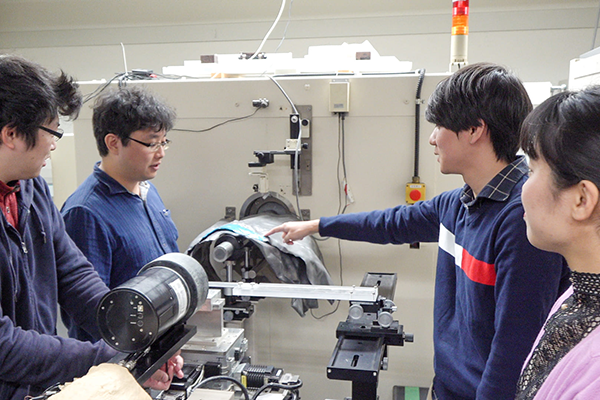NEUTRON SCIENCE
TAKATSUGU MASUDA LAB.
INTRODUCTION OF LABORATORY
Here we will introduce two examples of our recent study, break down of quasiparticle in antiferromagnet and nematic correlation in frustrated magnet. Many phenomena in condensed matter science can be explained by using the concept of quasiparticle. For example antiferromagnetic order is a result of Bose condensation of magnons and superfluidity is those of phonons. The quasiparticle, however, can be unstable and decay if allowed by conservation laws. It was initially predicted in superfluid Helium and was identified by a termination of the excitation at twice the energy of a roton. Recently the magnon version of the spectral termination was predicted in the 2D square lattice Heisenberg antiferromagnets (SLHAF) in high magnetic field. At zero field a two-magnon continuum spreads in the higher energy region for all wave vector q and there is no decay channel. With increasing field the one-magnon branch moves to higher energy around q = (π π) and eventually overlaps with the continuum at a threshold field. The hybridization of one-magnon with two-magnon continuum induces instability of the one-magnon. Our group experimentally observed the magnon instability in S=5/2 SLHAF Ba2MnGe2O7 by using neutron scattering technique. One of the recent interests in condensed matter science is to search for a spin liquid that exhibits order not in a conventional two-spin correlation but in other correlations such as magnetic multipole or spin chirality. A 1D frustrated spin chain with a ferromagnetic nearest-neighbor interaction ( J1) and an antiferromagnetic next-nearest-neighbor interaction ( J2) is diversity of such novel states. In zero field vector spin chirality does order with a broken Z2 symmetry. At a field close to the ferromagnetic polarized phase, a pair of magnons form a bound state, and its Bose condensation at approximately q = π induces the quasi-long-range order of transverse spin nematic correlation 〈S+0 S+1 S?l S?l+1〉. At the same time longitudinal two spin correlation exhibits spin density wave like sinusoidal behavior. Our group explored such novel states in ferromagnetic frustrated chain LiCuVO4 and identified the SDW-like order in high magnetic field.

図:(A)-(C) さまざまな圧力下で測定されたCsFeCl3の中性子スペクトル。大気圧下(A)と0.3ギガパスカル(B)では1本のスペクトルが観測されたが、量子臨界点近傍の1.4ギガパスカル(C)では複数の特徴的なスペクトルが観測された。
S. Hayashida et al., Sci. Adv. 5, eaaw5639 (2019).

(D),(E)中性子スペクトルの計算結果。位相モードと振幅モードの混成を考慮した計算(D)は実験(C)を再現するが、考慮しない計算(E)は実験(C)を再現しない。
S. Hayashida et al., Sci. Adv. 5, eaaw5639 (2019).


MESSAGE
EXPERIENCE AND ENJOY A DISCOVERY BY YOURSELF. YOU WILL BE ADDICTED TO PHYSICS WORLD!
Masuda group studies novel quantum phenomena realized in low dimensional quantum spin system, oxygen molecule magnet, and multiferroics materials by combination of crystal growth, bulk property measurement, and neutron scattering. Any students who have interest in quantum phenomena, crystal growth, bulk property measurement, neutron scattering experiment, doing experiment abroad, presentation abroad at international symposium, etc., are very welcomed to our group.
keyword
Neutron scattering / Quantum spin system / Magnetism / Neutron spectrometer / Quasiparticle / Quasi-one-dimensional antiferromagnet / Inelastic neutron scattering / Spin Seebeck effect / Spinon spin current / Spin current / Electromagnon / Spin dynamics / Multiferroics / Frustrated system / Polarized neutron / Spin nematic state / Frustrated system / Quantum phenomenon / Quantum spin / Quantum ferrimagnetism / Quantum ferrimagnet / Artificial oxygen molecule magnet / One-dimensional XXZ antiferromagnet / X-ray diffraction / Magnetic susceptibility measurement / impurity effect / pressure effect / frustration / antiferromagnetic state / spin-Peierls system
PROFILE : Associate Professor Takatsugu Masuda
1996 Department of applied physics, Faculty of engi neering, University of Tokyo
1999 Research associate, Department of Advanced Materials Science, Graduate School of Frontier Science
996 Department of applied physics, Faculty of engi neering, University of Tokyo
1999 Research associate, Department of Advanced Materials Science, Graduate School of Frontier Science
2002 Dr. Technology, Department of Applied Physics, University of Tokyo
2002 Postdoctoral research associate, Oak Ridge National Laboratory
2005 Associate professor, Yokohama City University
1996 Department of applied physics, Faculty of engi neering, University of Tokyo
1999 Research associate, Department of Advanced Materials Science, Graduate School of Frontier Science
996 Department of applied physics, Faculty of engi neering, University of Tokyo
1999 Research associate, Department of Advanced Materials Science, Graduate School of Frontier Science
2002 Dr. Technology, Department of Applied Physics, University of Tokyo
2002 Postdoctoral research associate, Oak Ridge National Laboratory
2005 Associate professor, Yokohama City University
2010 Associate professor, Institute for Solid State Physics, University of Tokyo
2024 Professor, Institute for Solid State Physics, University of Tokyo.
STUDENT VOICE : SHUNSUKE HASEGAWA
Prof. Masuda is always earnest not only in research but also in education. He patiently teaches us until we reach full understanding of topics. Even though our idea in research is crazy, he sincerely considers it and a realistic solution is fed back. In our group, each member is conducting the research at his/her own pace. On the other hand, we can get fruitful advice from weekly meeting and daily conversations. When a new phenomenon is discovered in a neutron scattering experiment after long and careful preparation, the sense of accomplishment is much greater than that of reaching summit of Mt. Fuji.

SOLID STATE PHYSICS AND CHEMISTRY
We aim to be the first in the world to conduct experimental observations.






Takatsugu Masuda Lab.,
Department Of Advanced Materials Science,
Graduate School of Frontier Sciences,
The University of Tokyo
Kashiwanoha 5-1-5,
Kashiwa,Chiba 277-8561, Japan
+81-4-7136-3415
masuda@issp.u-tokyo.ac.jp
The Goal of Applied Physics
The goal of Applied Physics is to develop a stage = “new material” that can manipulate undeveloped degrees of freedom, to explore unknown phenomena created from that stage and to bring out excellent functions, and to bring out its excellent functions. The purpose is to contribute to the development of human society by elucidating the mechanisms and developing application fields for these phenomena and functions.
AMS (Advanced Materials Science)
Department Office
AMS (Advanced Materials Science),
Graduate School of Frontier Sciences,
The University of Tokyo
Kashiwanoha 5-1-5, Kashiwa, Chiba 277-8561, Japan
Email : ams-office(at)ams.k.u-tokyo.ac.jp
Please change (at) to @.
